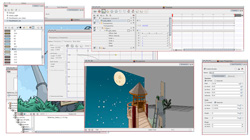Toon Boom Animate
POWERFUL VECTOR-BASED ANIMATION SOFTWARE
 Ask Web animators what application they use, and the majority will tell you it’s Adobe Flash. That’s too bad. Although Flash CS4 has made great strides by adding 3D and inverse kinematics (bones) to its toolset, it’s a limited animation program when compared to Toon Boom Animate.
Ask Web animators what application they use, and the majority will tell you it’s Adobe Flash. That’s too bad. Although Flash CS4 has made great strides by adding 3D and inverse kinematics (bones) to its toolset, it’s a limited animation program when compared to Toon Boom Animate.
Toon Boom Animate includes the following features that Flash lacks: lip-syncing, 3D multiplane cameras, cell swapping, multiple brush tools, and motion blur. Like Flash, Animate includes onion skinning, animateable effects, path editing, gradients, inverse kinematics, masks, reusable symbols, sound support, layers, vector shape tools, and multiple color palettes.
Animate’s palette support is much more complex and fully featured than that in Flash. For instance, each drawing tool in Animate can have its own color. In Flash, if you chose stroke and fill colors, all drawing tools will use those colors. Morphing in Animate is also much more feature-rich than it is in Flash (where it’s called Shape Tweening). Animate contains a suite of tools and controls to allow you to get exactly the morph you want, and it can import most standard formats, including MOV, SWF, PSD, AI, and PDF. It can export QuickTime movies, FLV, and SWF (Flash) files.
As a long-time Flash animator, I most enjoyed using Animate’s lip-synching tools, as this task has always been arduous in Flash. Animate lets you draw mouth shapes for each common sound. It then analyzes the audio and automatically maps mouth shapes to the soundtrack. You can override its analysis if necessary, manually choosing which mouth shape to use at a specific time.
Traditional animators will love the fact that Animate includes Xsheets (exposure sheets), which are spreadsheet-like charts used to plot out animations in a standard film and video workflow. Animate’s Xsheets are more than just charts; you can plot keyframes on them instead of on the Timeline if you prefer that workflow. I find it best to use both the Timeline and the Xsheet. The Xsheet gives you many more details about what’s going on in each frame; the Timeline gives you a quicker, more-compact overview.
A strong point for Flash is also one of its weak points: its small number of tools. The smaller the tool set, the easier the application is to learn. New users can be up and running with Flash within a few hours. On the other hand, Animate’s complexity means a steeper learning curve without the plethora of books, courses, and online training videos you can find for Flash. To help new users, Toon Boom has loaded their website with training videos and “getting started” documents.
Another strong point in Flash is ActionScript. Flash isn’t just an animation tool, it’s also a computer-programming platform. Toon Boom has wisely chosen to focus only on animation, so you can’t use Animate to code interactive movies or games, but Animate does include a scripting language that allows you to automate repetitive tasks in the application itself.
One thing missing from Animate is a Type tool. If I had to choose between animating text in Animate or Flash, I would choose Flash. Although Flash has a Type tool, its text-animation features are sorely lacking. I usually animate text in After Effects, which includes the most advanced text-animation tool I’ve found.
Available for both Mac and PC, Animate retails for $999.99. Compare that with Flash, which is few hundred dollars cheaper, retailing at $699. Those prices seem about right, given the animation features of the two applications.—Marcus Geduld
Company: Toon Boom Animation Inc.
Price: $999.99
Web: www.toonboom.com
Rating: 4.5
Hot: Full-featured; powerful tool for professional animators
Not: Pricey compared to Flash; no Type tool
